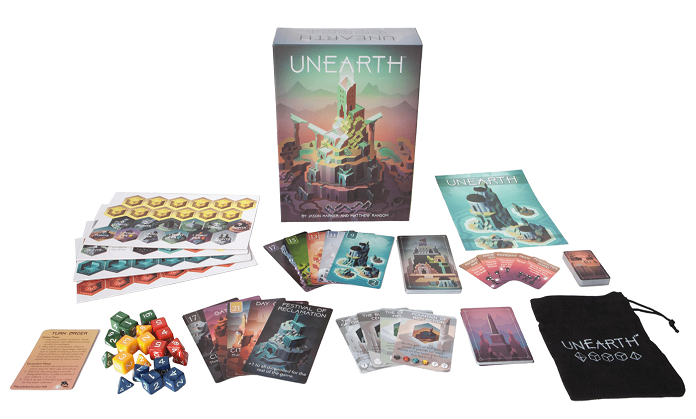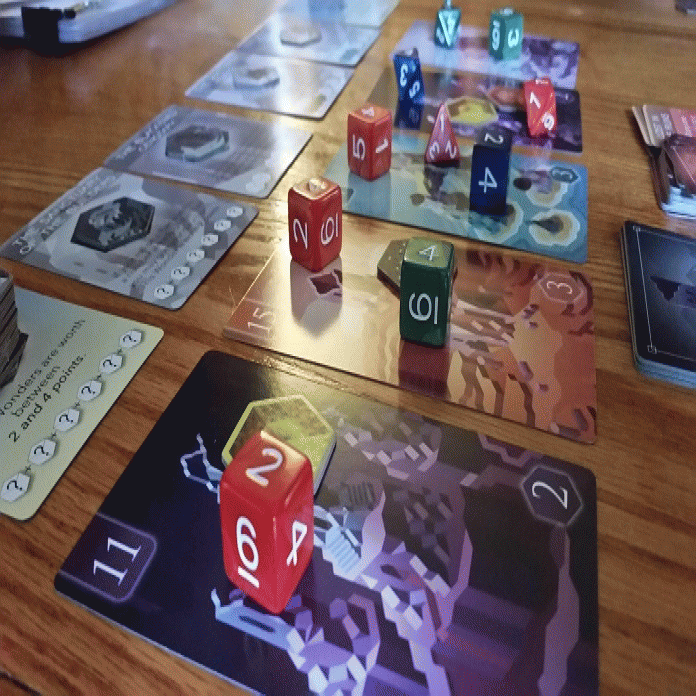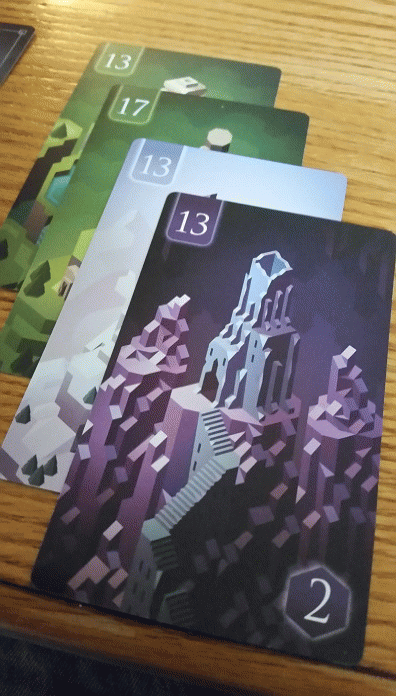
PLAYlist 15: Unearth
I have a love-hate relationship with dice. In all of the old roll-and-move games we grew up with – say, Monopoly – they feel dreadfully outdated. In roleplaying games, where a roll of a die can determine whether you lop off an orc’s head or gore your own leg, it can feel, well, maybe too random. In big wargames like Risk, having the combat boil down to the luck of a roll has a way of cheapening all of the other strategies playing out at the table.
Nowadays you don’t see as much of that “roll and pray” style of dice usage in games as you used to. If there are only a few ideal outcomes – a high roll, or rolling specific number – is it really any more interesting than flipping a coin over and over again? If you come across a modern game built around opponents out-rolling one another, it feels like a lazy design choice.
Still, there’s something inherently exciting about rolling dice. When your fate hinges on the way hunks of plastic land on a table, there’s a thrill in that. It’s the gambler’s rush, you know? Clever designers acknowledge this, and have found ways to tap into the anticipation and nervousness that comes with dice rolls and make them about more than arbitrary, good or bad results. More often than not the dice in those games don’t produce random numbers, but random choices to make.
If you’d like a great of example of clever dice usage in a game, well, look-ee here. The subject of our column today is Unearth, a new release from Brotherwise Games by designers Jason Harner and Matthew Ransom. This game will see 2 – 4 players rolling colorful dice early and often. What we love about it is that almost every side of every die is as good as any other (provided you use them smartly.)
In Unearth, you play as Delvers – archeologists, adventurers, explorers – from a mysterious alien race. Centuries ago your ancestors built great civilizations across the planet, but they’ve long since been grown over by forests and sunken into the seas: returned to nature from whence they came. Your goal, as a sort of extraterrestrial Indiana Jones (Alpha Centauri Jones?), is to locate your ancestors’ lost palaces, monuments, and cities, and reclaim them for your own before competing Delvers claim the gory out from under your nose.
A four-player game begins with five ruins cards taken from the top of the deck and spread out in a tableau. (These beautifully-illustrated cards are big. Think: Tarot-sized.) Six special Wonder tiles are taken from another deck and spread out above these, alongside piles of tiles representing generic greater and lesser wonders. Each player is dealt one ruins card in secret, and some are removed from the deck to make card-counting impossible. Colored, hexagonal stone tiles are pulled from a drawstring bag and placed, three each, on the face-up ruins cards. Finally, each player is dealt two teeny-weeny delver cards, and gameplay begins.
On each turn, a player does two things. First, they may play any number of delver cards from their hand; these provide one-time-use special powers, such as the ability to re-roll a die or change your mind about where you’ll place it. Afterward, they pick one of the face-up ruins cards on the table, then one of their dice, and roll.
 Each player has five dice at their disposal: three of your standard, six-sided dice, one four-side pyramid die, and an eight-sided die. When a die is rolled, it’s placed – showing whatever value you rolled – on the ruins card you selected. Every ruins card has a number value in the upper corner, and once the total sum of the dice reaches or exceeds that number, that ruin goes to the player with the highest-valued die on it. (Ties are broken by the size of the die; i.e., a five on an eight-sided die is worth more than a five on a six-sider.) Whenever a ruin is claimed, it’s replaced with a new one from the top of the deck. All dice that were on that card are returned to their owners, and those who didn’t win the ruin get to draw delver cards for each die returned to them.
Each player has five dice at their disposal: three of your standard, six-sided dice, one four-side pyramid die, and an eight-sided die. When a die is rolled, it’s placed – showing whatever value you rolled – on the ruins card you selected. Every ruins card has a number value in the upper corner, and once the total sum of the dice reaches or exceeds that number, that ruin goes to the player with the highest-valued die on it. (Ties are broken by the size of the die; i.e., a five on an eight-sided die is worth more than a five on a six-sider.) Whenever a ruin is claimed, it’s replaced with a new one from the top of the deck. All dice that were on that card are returned to their owners, and those who didn’t win the ruin get to draw delver cards for each die returned to them.
Because the values on the ruins cards are so high, you’ll need multiple dice to win any one of them. Rolling a high number brings you closer to winning a particular ruin, but it also puts it within closer reach of your opponents. When your turn comes around, you may find that your opponents have rolled a ruin within striking distance – not necessarily the one you wanted, buuuuuuut… – and you’ll have no choice but to jump on a plum opportunity.
In this case, the randomness of the dice provides shifting opportunities for all of the players, and keeps everyone engaged in not only what they’re rolling, but their opponents’ rolls. That’s clever dice usage, part one. Unearth doubles down on that creativity by providing players an incentive to roll low numbers as well.
When a player rolls a one, two, or three on any die, they can claim one of the stone tiles on the ruin card. (Or, draw one from the bag, if they’ve all been claimed already.) They’ll arrange these tiles in front of them, connecting sides to create loopy patterns that resemble tangled DNA strands. Once they’ve chained together six of these tiles in a circle, they can take one of the wonder tiles from the tableau and place it in the center of their chain. The generic wonders are worth big points at the end of the game. If you were slick about which colored stone tiles you grabbed, you might be able to take one of the special wonder tiles on display. These not only grant you points at the end of the game, but special powers you can use through the rest of it – from adding or subtracting numbers on all future die rolls, to re-rolling in special situations.
And thus, Unearth offers several viable, branching strategies to follow: you can try to win ruins cards with high rolls, or game the stone tiles for wonders with low rolls. In particular, this has a major effect on which dice you’ll choose to roll, as the number of sides increases the likelihood you’ll get the high or low number you’re hoping for. The beauty of it all is that because your dice rolls are totally random, the path you’re on is likely to change several times as the game goes on.
That, folks, is how you make rolling dice fun.
Unearth ends when you run out of ruins cards. (The last card in the deck will always be an End of Age card, which adds a fun wrinkle to the rules for the last few rounds and is randomly selected during setup – this provides even greater variance between games.) You score points by collecting colored sets of ruins, or one of each type. These are added to the points you’ve won via wonders, and there’s a bonus for building three or more of those in total. As in most games save golf, the player with the highest score wins.
I really like Unearth. It’s a game that forces you to constantly be thinking: not only do you have a choice to make on your turn about which die you’ll roll and on which ruin, but you’re eagerly watching your opponents’ rolls to see how they change the landscape and re-shape what you’ll be able to do when your turn comes around again. And while there are a significant number of choices to be made in each turn, there’s not a lot you actually need to do. (Play a card or not, roll your die, and then it’s the next player’s turn.) It keeps everything moving at a wonderfully brisk pace. Sure, you’ll get the occasional pause when a player needs time to re-consider their strategy, but this is mitigated really well when everyone is engaged in the game and paying attention to their opponents’ moves. It’s all over in an hour (at four players) or less, which is perfect for a game of this weight.
Before wrapping up this review, I want to point out what should be obvious from the photos, but Unearth is a very pretty game. The cool color palette and Escher-inspired architecture depicted on the cards make it very pleasing to the eyes; the high-quality dice and adorable Martian-people on the delver cards are two more little touches that add a great deal to the game’s production value. When you open the box and spread out the components, it looks and feels like a game that should cost more than its $35 MSRP.
This column’s music playlist isn’t as much inspired by the game we’ve covered, but by the company that published it. Brotherwise Games was launched in 2012 by brothers Chris and Johnny O’Neal. Their first game, the 8-bit-inspired dungeon builder Boss Monster, was a massive Kickstarter hit, and has since spawned a sequel and numerous spin-offs. (Full disclosure: Boss Monster was one of the games to truly re-ignite our love for tabletop gaming, and this column may not exist had it not come around when it did.) Unearth is their first game post-Boss Monster, and hopefully it’s clear from our review above that we think Brotherwise will be more than one-hit wonders.
Every one of the bands represented in the above playlist has at least one pair of brothers in their lineup. Some are the obvious ones (Oasis, the Allmans, the Beach Boys) while others less so. Enjoy! And if you have a brother, maybe shoot him a text saying “Sup, dude.” I’m sure he’d like that. (Look at us, bringing families together!)
***
Previous PLAYlist columns: Escape from 100 Million B.C., Orleans (plus Trade & Intrigue), Whistle Stop, Caverna: Cave vs Cave, Twilight Struggle, Honshu, Bärenpark, Notre Dame & In the Year of the Dragon, Yokohama, Clank! A Deck-Building Adventure, Villages of Valeria, New York Slice, Watson & Holmes, Hanamikoji.
Current Issue

Issue #72
Apr 19, 2024 Issue #72 - The ‘90s Issue with The Cardigans and Thurston Moore
Most Recent
- 10 Best Songs of the Week: Nilüfer Yanya, Linn Koch-Emmery, Fat Dog, Crumb, St. Vincent, and More (News) —
- Fat Dog Announce New Album and Tour, Share Video for New Song “Running” (News) —
- The Obsessed, Howling Giant @ Brooklyn Meadows, NYC, April 12, 2024 (Review) —
- Premiere: Slow Joy Releases New Single and Video for “King Cowboy” (News) —
- Premiere: Mackenzie Shrieve Shares New Single “Didn’t I Tell Ya” Feat. Jane Bruce (News) —

Comments
Submit your comment
November 2nd 2017
4:51am
should i take imodium <a >simpbreathabad17-domperidone</a> rabeprazole and levosulpiride combination uses
December 29th 2017
4:54am
Great Job, your post content Too short but Very well define and much effective.
Black Magic Removal in Islam
January 22nd 2018
3:37am
nice blog February Monthly Calendar 2018
December 18th 2018
12:49am
I really liked the color scheme of your page.
Islamic Voodoo Spell